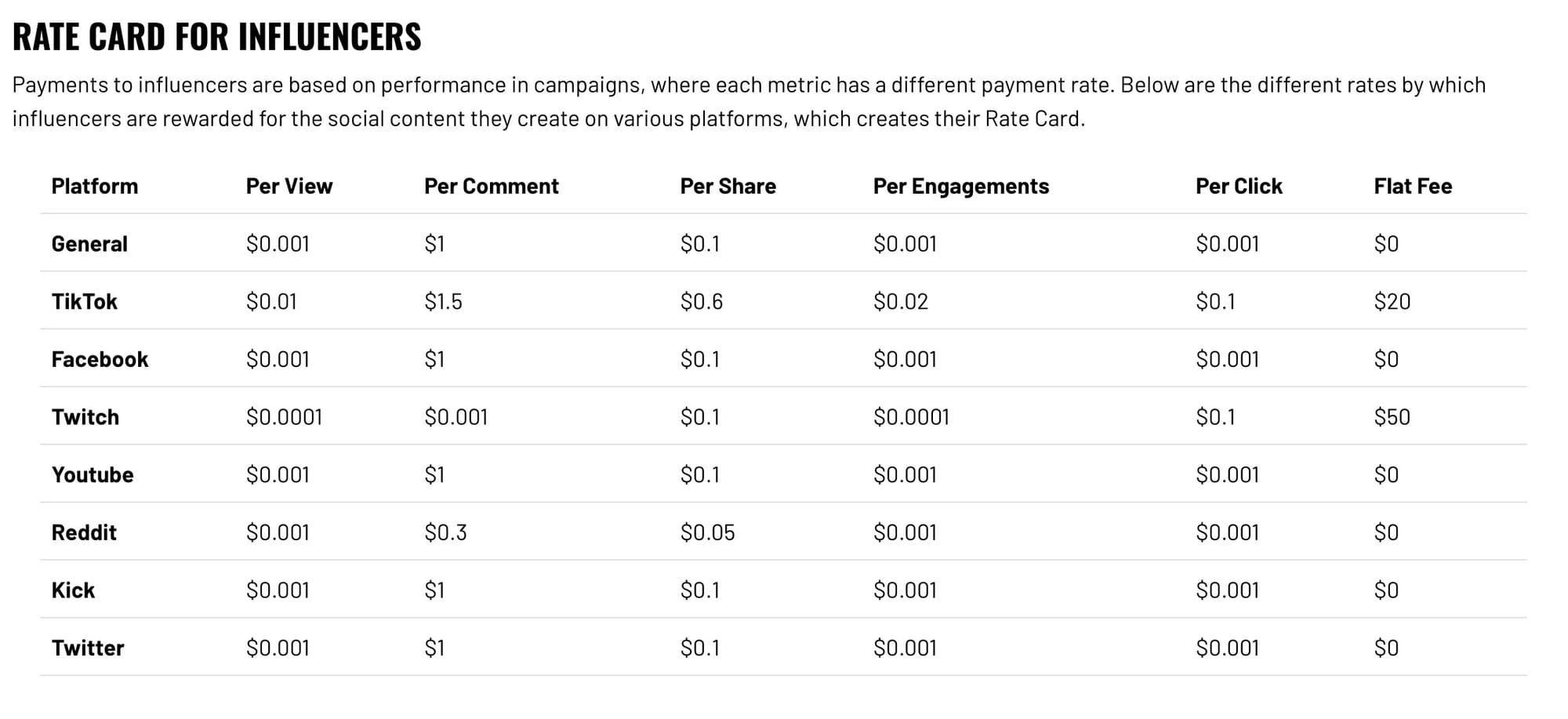How Influencer Marketing Can Lower A Game's Cost Per Installation
Explore game marketing strategies with insights on CPI, UAC, ARPU, and LTV. Learn how performance-based influencer marketing can optimize user acquisition costs and enhance profitability in the gaming industry.

Bringing a game to market is challenging, and it often requires a significant budget for marketing and promotion. While the total budget is a major factor in game marketing, another crucial aspect to consider is user acquisition, or the cost of acquiring each user.
In this article, we will explore game marketing from a numerical perspective, examining the levers that need to be adjusted to optimize results in marketing a game and acquiring users. We will also learn how performance-based influencer marketing can be fine-tuned to deliver optimized outcomes.
The Metrics in Game Marketing
There are a few important terminologies to understand in game marketing before delving into how performance-based influencer marketing can lower user acquisition costs. Below, we will cover various terms and how they are calculated.
Cost Per Install (CPI)
CPI measures the cost for one user to install your game. This value is calculated by dividing the total acquisition spend by the number of installations. Here's an example of CPI:

A gaming company spends $1,000 on an ad campaign for their mobile game. As a result, 250 users download and install the game. The CPI is calculated as the total advertising cost divided by the number of installs:
CPI = Total Advertising Cost / Number of Installs
CPI = $1,000 / 250
CPI = $4
So, the Cost Per Install for this campaign is $4 per user.
User Acquisition Cost (UAC)
The User Acquisition Cost (UAC) for console games is calculated by dividing the total costs associated with acquiring new users (such as marketing, advertising, distribution, platform fees, and promotional discounts) by the number of new users acquired. The formula is:

The total costs typically include expenses related to marketing campaigns and platform distribution fees. However, the specific components can vary based on the publisher's or developer's business model and accounting practices.
Conversion Rate
The conversion rate refers to a user who pays or generates revenue for the game. In free-to-play games, this rate is calculated when revenue is generated through ads, in-app purchases, etc. In one-time payment games, the conversion rate occurs when the user buys the game.
Average Revenue Per User (ARPU)
Average Revenue Per User (ARPU) in the gaming industry is a financial performance metric used to measure the average income generated per user or player. It is calculated by dividing the total revenue generated from a game by the total number of users or players over a specific period.

ARPU is crucial for gaming companies as it helps understand the game's earning potential and profitability. It is particularly important in free-to-play games, where revenue is often generated through in-game purchases and advertisements, rather than initial sales. This metric aids in evaluating the effectiveness of monetization strategies and understanding user engagement and spending behavior.
Life Time Value (LTV)
Life Time Value (LTV) in gaming measures the total revenue a single player is expected to generate throughout their entire period of playing a game. Calculating LTV in gaming involves considering various revenue streams such as game purchases, in-game transactions, subscriptions, and advertising revenue. It can vary between mobile games and console games, primarily due to differences in their business models and player engagement patterns:
1. Mobile Games:

- Business Model: Mobile games often use a free-to-play (F2P) model, relying on in-app purchases and advertising for revenue. They may also offer subscriptions for premium content.
- LTV Calculation: For mobile games, LTV is heavily influenced by factors like in-app purchase frequency, ad views, and subscription renewals. The formula may include average revenue per user (ARPU), retention rates, and average player lifespan.
- Key Factors: Retention rate, conversion rate, and average transaction value are crucial for LTV in mobile games.
2. Console Games:

- Business Model: Console games traditionally rely on one-time purchases but may include additional revenue streams like DLCs, expansions, and in some cases, subscriptions or micro-transactions.
- LTV Calculation: For console games, LTV calculations might focus more on initial game sales, frequency of DLC or expansion purchases, and any recurring revenue streams like season passes.
- Key Factors: The initial purchase price, rate of DLC or expansion purchases, and longevity of player engagement are significant for LTV in console games.
Current Marketing Trends
With an understanding of the terminology, we can now explore some of the current trends in game marketing. Below are various trends, ranging from average Cost Per Install (CPI) to conversion rates for games.
Cost Per Install (CPI) For IOS:
- IOS Games: $4.30
- Android: $1.15
- Steam Console Games: $2 to $4
- Steam PC Games: $1.5 to $2.5
LTV For Mobile Games:
- Hypercasual games: $0.20– $0.40 cents
- Casual games: $1–$3
- Mid-core games: $2–$5
- Casino games: ~$15
Conversion Rates:
- Steam Indie Games : 1% - 3%
- Steam AAA Games : 3% - 7%
- iOS Games: 2.3%
- Android Games: 1.78%
The Real Cost Of User Acquisition

To be profitable, your users must spend more than it costs to acquire them. Let's consider a hypothetical scenario where your Cost Per Install (CPI) is $2 to acquire new users, and your conversion rate is 3%. It’s important to note that just because a user installs a game does not mean they generate revenue, hence the conversion rate.
For a gaming company to be profitable and support a business or lifestyle, this needs to scale to hundreds of thousands or millions of gamers. To illustrate how expensive a $2 CPI is, if you want to acquire 50,000 users, you will have to spend $100,000! That’s expensive!
Now, if the conversion rate is 3%, this means that for every 100 users you acquire, only 3 of them convert to paying users. The cost to acquire one paying user in your scenario is approximately $66.67. Therefore, to break even, the Average Revenue Per User (ARPU) for free-to-play games should be at least $66.67, and the User Acquisition Cost (UAC) for one-time purchase games is also $66.67.
When you incorporate the Lifetime Value (LTV) of a game, free-to-play games face the challenge of keeping the user engaged long enough to make the ARPU. Using the above scenario, if a user generates $10 in revenue a month, they must stay engaged with the game for 6.7 months to cover the $66.67 cost of acquiring them.
Lowering Acquisition Cost With Performance-Based Influencer Marketing
The reason why influencer marketing is an effective form of marketing is because of its conversion rates. As discussed above, higher conversion rates into paying users or users who generate revenue lead to profitability. With influencer marketing, the conversion rate is between 1% to 5%.
Influencer marketing works by finding an influencer with a large following who you think might be interested in your game. Then, you pay them a flat rate to create content for your game, typically either a stream or social media post.
The problem with traditional influencer marketing is that the payment to an influencer doesn’t always translate to new users, leading to poor user acquisition costs. Performance-based marketing remedies this problem by rewarding the influencer based on the metrics they achieve. The process on platforms like Glitch uses a rate card to set what metrics you want an influencer to focus on, as seen in this example rate card below.

As the influencer executes their campaign, they are paid based on the metrics they produce. For example, if the price is $0.30 per comment and their post on Reddit gets 75 comments, the influencer will earn $22.50. The publisher can set which metrics they want to pay more or less for on the rate card to influence what the influencer will focus on in an effort to produce desired results. For example, if the publisher believes clicks will lead to higher conversions, clicks can be priced higher than views or comments.
The strategy you want to implement is keeping your CPI as low as possible. Let’s consider this scenario:
- An influencer creates a TikTok video that gets 20,000 views at $0.001 per view.
- The video gets 50 comments at $0.20 per comment.
- The price is set at $0.70 per click, and there are 100 clicks.
- At a 1% conversion rate, the game gets 200 installs (clicks + views).
The total cost of the influencer marketing campaign is $100. From this campaign, the Cost Per Install (CPI) is $0.50. The cost of acquiring 100 users, at a CPI of $0.50, is $50. Therefore, to break even, the ARPU should be at least $50. In conclusion, even at potentially lower conversion rates, performance-based influencer marketing can be tweaked to yield a better CPI than other forms of marketing.
Using Glitch For Performance-Based Influencer Marketing
Effective game marketing requires a deep understanding of various metrics like Cost Per Install (CPI), User Acquisition Cost (UAC), Conversion Rate, Average Revenue Per User (ARPU), and Lifetime Value (LTV). These metrics are crucial in strategizing and assessing the profitability of a game. Additionally, exploring current trends and adapting strategies like performance-based influencer marketing can significantly lower acquisition costs and improve overall profitability.
Platforms like Glitch offer the ability to set your own price for marketing your games with content, and create collaborative campaigns. As the gaming industry continues to evolve, staying informed and agile in marketing approaches is key to success.




